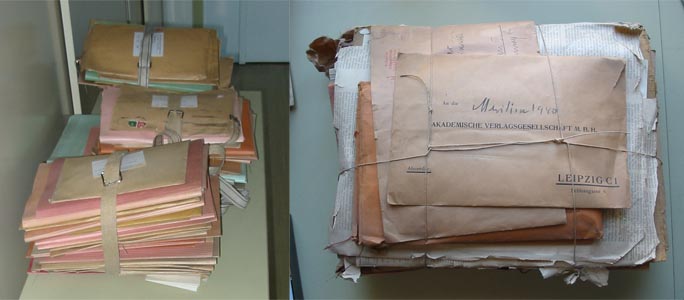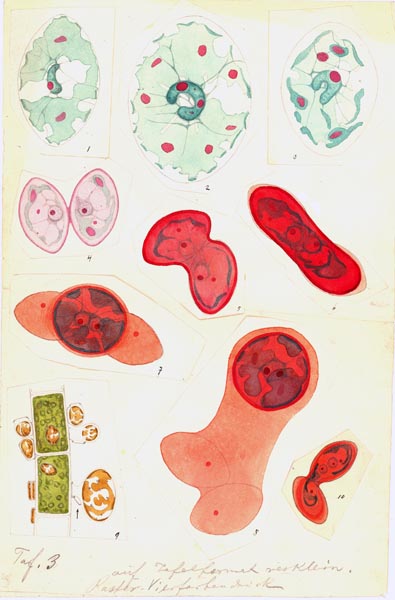The Geitler Collection (University of Vienna)

Manuscripts
The proofs of most of Geitler's papers, together with many of
the original illustrations he prepared using pen and ink, ink washes,
pencil, or watercolour, have survived and are stored in envelopes or
folders. The folders are tied together into bundles (formerly using
string, now by herbarium straps), more or less according to the date of
publication.
Some folders contain only the proofs and original
illustrations. Others contain additional illustrations not used in the
final version of the manuscript or extra sheets of observations, and
there may also be correspondence
with the journal editor, publisher or
others. No catalogue has yet been made. Sometimes, Geitler re-used
illustrations from earlier papers. For example, in his 1977 paper on
the diatom family Epithemiaceae [L. Geitler (1977). Zur
Entwicklungsgeschichte der Epithemiaceen
Epithemia, Rhopalodia und Denticula
(Diatomophyceae) und ihre vermutlich symbiotischen
Sphäroidkörper. Plant
Systematics and Evolution 128, 259--275]
Geitler re-used a plate of beautiful half-tone illustrations of
auxosporulation in Epithemia
zebra var. saxonica,
originally published in 1932. In such cases, it seems that the earlier
illustration will usually be found associated with the later paper.
Unfortunately, however, the Epithemia plate
seems to have been lost.

Image:
this is a scan of the original watercolour illustrations of stained Cocconeis prepared
for the first of Geitler's important series of publications on the
freshwater diatom Cocconeis
placentula. Originally prepared on other sheets of paper,
the individual figures have been cut out and pasted onto a single sheet
for reproduction via colour lithography.
Most of the material illustrated in this plate was fixed in
Flemming's solution (which contains osmium tetroxide) and stained with
safranin (red) and light green. However, the illustration bottom left
shows living cells attached to a Cladophora
filament.
Between the 1920s and the 1980s, Geitler studied
the cytology,
cell division, life cycles, epiphytism, speciation and taxonomy
of Cocconeis
placentula.
This work helped establish our modern understanding of the nature of
diatom species, according to which diatoms are extremely
species-rich, with many pseudocryptic or cryptic species. However,
Geitler was himself highly conservative taxonomically,
preferring
to work within the existing framework of species established by F.
Hustedt and previous diatom taxonomists. Thus reproductively isolated
and morphologically distinct demes (which Geitler referred to as
'Sippen') were described as varieties or given no formal recognition.
The plate was published as plate 14 in L. Geitler (1927).
Somatische Teilung, Reduktionsteilung,
Copulation und Parthenogenese bei Cocconeis
placentula. Archiv
für Protistenkunde 59: 506–549.



